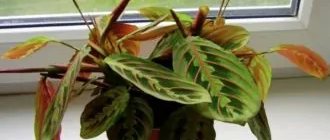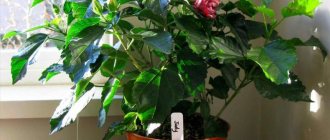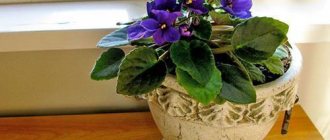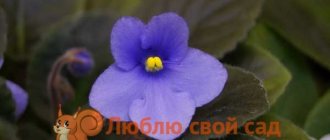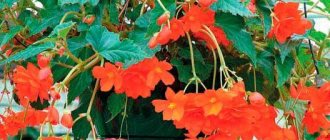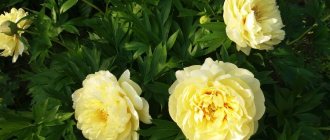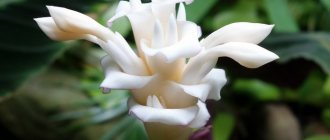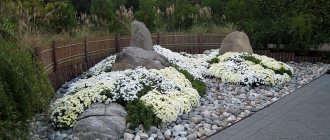Today we will introduce you to the types and varieties of an exotic plant - arrowroot. The plant came to us from the tropical forests of South and Central America. Arrowroot is valued for its incredibly beautiful patterns on the leaves, which are very different for each variety. Thanks to this, any gardener will be able to choose a variety to suit his own taste.
Description
Arrowroot is an ornamental herbaceous perennial from the Marantaceae family. It is named after the medieval physician and botanist Bartolomeo Maranta. Sizes and appearance vary greatly depending on the variety. At home you can rarely find arrowroot taller than 30 cm, however, in natural conditions the height of the bush can reach one and a half meters. The leaves are large, patterned, and oval in shape. A young specimen has erect stems, but with age they lean more and more toward the ground.
This is interesting! With the onset of darkness, arrowroot raises its leaves to the sky, exposing their back side. This is very reminiscent of a believer folding his hands in prayer. This is where the plant got its second name - “Prayer Plant”. Arrowroot also has a third name, and, oddly enough, it is also associated with religion. The shape of the leaves resembles the tablets of Moses, and each leaf has 10 spots, just like the number of commandments on the tablets. That’s why some people call arrowroot the “10 Commandments.”
The root system of arrowroot is represented by tubers. The tubers of some arrowroot species are edible and are cultivated in several countries. Starch is also extracted from them for use in medicine.
Specific features
In the natural environment, the culture grows in the swampy and forested areas of America. These are small specimens with a tuberous root up to 30 cm high, but there are also giants up to 2 meters. From the description of the flower, it is clear that its popularity is due to its decorative leaves, which have an elliptical or oval-round configuration and an unusually interesting coloring, including all transitions of green and even a red-black tint.
Due to the unusual ability of the leaf blades to change their position in the evenings, rising upward and folding in the shape of folded hands, it received the name “praying grass.”
Varieties of arrowroot
Several dozen different types of indoor plants are grown at home. The most popular types of arrowroot with photos:
Two-color arrowroot
The main difference between this flower is the absence of tubers. The leaf has an oval shape and is dark and light green in color. The edge of a bicolor arrowroot leaf is usually wavy.
Tricolor arrowroot
It is distinguished by red veins on the leaf blade. The color of the leaves also contains green and yellow. The reverse side of the sheet is painted crimson.
Reed arrowroot
This plant has slightly elongated leaves. They are also painted in dark and light green, while the light spots on the sheet may be located asymmetrically.
Overview of genera and their species
The arrowroot family has about 400 species. They are divided into 30 genera. The most popular of them are arrowroot, calathea, stromanta and ctenantha. They all require approximately the same care and maintenance. Flower growers note that there are no particular difficulties in growing, but it can still be difficult for beginners.
Maranta
If we are talking about indoor arrowroot, it can reach a height of only 20-30 centimeters. In the wild, this plant grows up to 1.5 meters. Among the features one can note the presence of rather short lodging shoots.
It is the arrowroot that is considered the flower that requires the least care. Indoor plants cannot always please their owners with flowering. If this happens, the buds turn out to be quite small, with petals of a soft purple or white color.
Among indoor plants, there are 7 varieties of arrowroot. Most often, gardeners choose three-color or two-color, Kerkhoven or Massange arrowroot.
Three-color can be called the most popular. It has leaf blades with bright red veins that are pink underneath. Around the stripes there is a yellowish or pale green halo, spreading out in spots towards the edges and at the same time becoming darker. The bicolor variety is distinguished by reddish-brown petioles and slightly wavy edges. There is a small fluff along the bottom of the leaves.
For inexperienced gardeners, the easiest way to grow Kerkhoven's arrowroot. She is the least capricious and does not require serious care. However, it looks no less bright and extravagant than other varieties.
Calathea
This variety has wide leaves with a spectacular and bright pattern of various shades. The pattern consists of spots and stripes. Such plants look very original, but you will have to take care of their care.
Calathea is quite tall and slender. If desired, it can be grown in a regular flower pot, but experts recommend placing the plants in a terrarium or organizing a “bottle garden” for them. They are quite capricious and cannot tolerate drafts. They are very sensitive to what kind of water will be used for irrigation. For active development, they need air with humidity in the range of 85-100 percent.
Some varieties react very negatively to the spraying procedure. They cannot be kept in the shower for a long time. They can have both beautiful, original shapes and nondescript leaves. However, they are distinguished by bright flowering. The most popular are Calathea saffron, Makoya, painted and pinkish-colored.
Stromantu
Externally, this plant resembles arrowroot, but the color of the leaves is closer to calathea. It can reach a size of 70-80 centimeters in height, while the leaves grow up to 20-35 centimeters. Their background can be anything. Some are distinguished by their variegation or the shine of satin. The lower part has a burgundy tint.
Stromantha can be called a plant for which the conditions of maintenance and care are the most important. Includes 13 varieties, but few take root at home. The most popular are the pleasant and blood-red stromanta.
Ktenantu
The leaves of this plant are arranged in a dense rosette, the tiers of which are divided by internodes. It must be said that the flower looks like a calathea. It is quite demanding in terms of conditions, so it is not recommended for growing for beginners.
The leaves are quite large, oval or oblong in shape. They are asymmetrical, which is why they often differ from other members of the family. They cannot boast of abundant flowering, and the inflorescences do not look very impressive. Among indoor plants, the most popular variety is Oppenheim.
Types of arrowroot - varieties with photos
There are a huge variety of arrowroot varieties, but several of them are usually grown at home and on the farm. These are mainly decorative varieties. Breeders are constantly developing new and interesting colors. Most of them can be classified into two categories: bicolor and tricolor, according to the number of colors in which the leaf plate is painted.
White veined arrowroot
The compact perennial bush gradually grows to a semi-ampeloid form. This category includes a number of varieties and subspecies with different leaf colors.
But the general outlines remain unchanged: oblong, medullary or wide leaves, approximately 7x10 to 10x15 cm. They grow at an acute angle relative to the petiole. The rhizome of the bush is developed, with oval tubers resembling potatoes. White veins appear on the leaf blade, which is why the variety got its name. The reverse side of the leaf is usually reddish.
Red veined arrowroot or Fascinator
This is a bright representative of tricolors. The main background of the leaf blade is dark green, sometimes brownish. The leaves become lighter towards the edges. A light stripe runs through the center, from which pronounced transverse veins diverge. They are colored red, the saturation of which varies from very pale to deep purple. Another feature is the broken direction of the stems.
Comb arrowroot
A medium-sized bush reaches approximately 40 cm. The succulent creeping rhizome is short, with fusiform thickenings for the accumulation of nutrients and moisture. The leaves are wide or oblong, up to 15 cm. The edges of the plate are slightly wavy.
The peculiarity of the comb arrowroot is its color. A continuous light green ridge appears on the green leaf, from which broad dark strokes radiate. They form a continuous border, and the ridge gradually becomes sharper.
Reed arrowroot
One of the most interesting and unusual species stands out against the general background. The height of the erect stems sometimes exceeds 120 cm. The leaves are elongated, egg-shaped. They become sharper towards the ends. The edge is painted in a dark bluish tint. The rhizome is densely strewn with tubers.
Maranta Kerkhoven
This is the most common and famous variety. The central vein appears on the dark sheet plate. On both sides of it there are symmetrical strokes, which darken and brown as they grow. At the same time, they remain separate and do not merge into one stripe. There are longitudinal veins, although they are practically invisible.
Maranta Maricella
The background of the leaf blade of this variety is dark green. This makes it stand out from the rest. But the veins and stripes are of a light light green color. This coloring is reminiscent of a classic negative.
Maranta Massanja
This is an exquisite variety, which is also called black arrowroot. Outwardly, it is not far from the classic white-veined one. The difference is that the underlying green background is retained around the edge. From the main vein, diverging longitudinal ones protrude sharply, maximally light or even white. Contrast is provided by dark strokes between them.
Maranta Emeral Beauty
It differs from the previous type in the width of the light stripe. It occupies up to half the sheet, and the color transition is gradual, without pronounced boundaries or spots.
Maranta Beauty Kim
This is one of the most variegated varieties with dark green or brownish spots, light green strokes, streaks and white stripes that can occupy up to half the leaf.
"Massange" (Maranta leuconeura Massangeana)
This variety can be classified as black arrowroot because they have a dark color in the middle of the leaf. The pattern on the leaves has a contrasting shade, the edges of the leaves are green, and there are light green stripes of lateral veins on the sides. The flower itself is miniature, 16 centimeters high.
You need to care for this variety carefully, as the variety is quite capricious.
"Marisella" (M. leuconeura Marisela)
The main background is dark green. Where the central vein is located, a jagged pattern is visible, and the side veins are practically invisible.
"Kerchoveana" (M. leuconeura Kerchoveana)
This is a tall and spreading variety. The leaves of the plant have an elongated shape and their length is 13-16 centimeters. The leaf blade has very bright colors. The background is bright green, with dark brown strokes and eyes. The leaves have spots that do not merge into a continuous mass. The bottom of the sheet is painted in blue and red tones. This variety has a height of 26 centimeters. The flowers are small in size, dim and collected in 2-3 pieces, have a pale lilac hue. The veins on the leaves have a non-relief shape and do not stand out in color at all.
"Beauty Kim" (leuconeura Beauty Kim)
The leaves are smooth, heart-shaped or oval-shaped, with sharp edges. The main background is light green with dark greenish spotted patterns. On the surface of the leaf there are strokes, stripes that have light green, pale yellow or white shades. A few leaves may only be half white. The patterns are located along the main and lateral veins of the leaf, but the veins themselves are dim.
"Emerald Beauty" (leuconeura Emerald Beauty)
This variety is similar in color to the previous one. It has variegated shades, but the pattern is blurry, the background itself is not contrasting, and there are no dark green spots. The leaves are shiny.
In addition to these varieties, there are more than 21 varieties. The varieties that were given in the article are distinguished by the bright color of their leaves. The remaining varieties could not take root in artificial conditions.
Arrowroot white-veined (or white-veined)
The homeland of this variety of arrowroot is Brazil. The plant has tuberous roots. The leaf blades have an elliptical shape. The leaves grow up to 15 cm long and up to 10 cm wide. The leaves are dark green on the outside and have a silver stripe in the center. There are light green patterns along the entire leaf blade, as well as white lateral veins.
The lower surface of the leaf blade may be reddish or blue-green. The petioles grow no more than 2 cm in length. These indoor flowers (arrowroots) can be found very rarely as a cultivated plant. In most cases, only its varieties are grown.
Home care
The secret to successfully caring for arrowroot is maintaining the temperature and humidity conditions.
The ideal soil for constant growth is a mix of leaf, humus and coniferous soil mixed with sand and charcoal. But standard fibrous peat will not work. Also avoid the presence of lime. Provide high drainage at the bottom.
Temperature
The plant does not tolerate heat and heat above +28...+30C. Avoid direct sunlight, drafts, and sudden temperature changes. Optimal in winter – up to +20C. In winter, it is undesirable to lower it below +14C. At this time of year it is important to keep the leaves away from the cold window.
Fertilizer
During active growth, use complex fertilizers. Specialized solutions for decorative deciduous varieties are now sold. But don’t overuse it, because it’s equally important not to overfeed the arrowroot.
Watering
It is recommended to repeat abundant watering only as the top layer of the substrate dries. During cold weather, reduce the frequency to avoid rotting of the rhizome. For irrigation, use filtered water, or at least soft, settled water. Arrowroot is sensitive to any foreign impurities.
Humidity
Ideal air humidity is about 70%. It can be compensated for by systematically spraying the leaves. This is especially important in summer and during the heating season. A tray with water will help to increase the humidity locally, but in this case, make sure that the moisture does not get on the roots.
Arrowroot feels most comfortable in partial shade. In direct sunlight and bright lighting it fades. In the apartment, pay attention to the windows that face northwest or east.
Growing problems
- The ends of the leaves are brown and dry, slow growth is a possible reason: the air is too dry or the plant is too dry. Another reason is the quality of the water (lots of salts, chlorine, fluorine, hardness). Also check if the plant is affected by spider mites. Remove dead leaves and maintain humidity above 50%.
- The ends of the leaves are yellow-brown - with an excess or lack of nutrients in the soil. You shouldn’t get carried away with fertilizers, especially if you have good quality soil. At the same time, depleted plants have pale, small leaves, and require replanting rather than feeding.
- The leaves curl, the lower leaves turn yellow - a possible reason: insufficient watering. The soil should not dry out too much, especially if the temperature is above 26°C.
- Sluggish stems, drooping shoots - if it is too cold and/or the soil is damp for a long time.
- Leaves lose color, turn pale, discolored and dry out - when sunlight is too intense, when the afternoon sun hits the leaves, or when attacked by mites.
Transplantation and propagation
Arrowroot transplantation should include the following steps:
- You should remove the plant from the old pot, carefully remove any lumps of soil, prepare a new container, pour drainage first, and then add some of the prepared soil on top.
- Clean the flower from old and yellowed leaves. Wipe healthy leaves from dust and debris. If the bush is large, then it can be cut off at the root.
- Move the plant to a new pot, fill it well with the rest of the soil mixture and tamp it lightly. It is important to carefully examine the composition of the soil before replanting. If there is lime in the soil, then such soil cannot be purchased. Lime will negatively affect the development of the flower.
- Now you need to select fertilizer and top dressing for the arrowroot. Fertilizer must be added once every 14 days. In winter, you only need to add it once a month. Nutrient components must be added along with the liquid in a ratio of 1:1. If the plant is dormant, there is no need to fertilize it, and water it 3 times less often.
Arrowroot is propagated by three classical methods:
- 1. When sowing seeds, start growing seedlings immediately with the arrival of spring. Take a wide flowerpot or box, peat-sand substrate and seeds. The first shoots appear in the next 2 weeks. The main thing is to maintain a stable temperature, about +16°...+19°. As soon as several full leaves appear on the seedling, it can be replanted.
- 2. To root cuttings, cut shoots up to 10 cm from the mother plant with several full-fledged healthy leaves. The whole process takes about 4 weeks. Rooting can be done from May to September. As soon as the root is formed, transplant the arrowroot into a peat substrate.
- 3. Mature and healthy shrubs can be propagated by division. Dig up and clean the bush, then carefully cut the rhizome. It is important that each seedling has several healthy leaves and tubers. Before transplanting, treat the cuts with charcoal to disinfect. After this, they can be planted in moist, loose soil.
It is recommended to replant an adult plant annually, in early spring.
Watering
The question of how to water a flower is fundamental to its normal functioning. Use only warm, settled water without impurities. In spring and summer, abundant watering will be required once every three days, and in winter a little less often as the surface layer dries.
The soil should not dry out, but swampiness, which threatens rotting, is also not acceptable. Constant air humidity is maintained by spraying with a spray bottle in the morning and evening hours.
Humidity is also ensured by installation on pallets, which are covered with damp sphagnum, pebbles, without contacting them with roots, or by placing a vessel with liquid next to it.
The Maranta plant loves water shower procedures; when bathing, the pot itself is covered.
Pest and disease control
Arrowroot problems are typical for tropical plants. With a lack of moisture or heat, it weakens and withers, but with an excess of water, root rot appears and fungal diseases develop. This can be prevented by maintaining a stable regime and periodically treating the flower with antifungal drugs.
Leaves are sometimes affected by scale insects. They suck out the juice, which causes the plate to change color, damage and sticky drops appear on it. Parasites are removed mechanically using soapy water. After this, spray the leaves with a special preparation.
When the air is too dry, spider mites appear. You can get rid of them with a hot shower, but this must be done quickly and carefully. But in this way you can destroy parasites without chemicals, and this is especially important in an apartment. There are also special acaricides for pests.
Plant temperature and lighting
In order for arrowroot to feel comfortable, it is necessary to maintain a balance of light and shadow. The best option would be diffused light. With an excess of sunlight, arrowroot leaves tend to change color and do not reach their maximum size.
Artificial lighting is also acceptable for growing arrowroot. But the plant can be under its influence for no more than 16 hours a day.
The temperature in the room must be maintained at the desired level, since arrowroot is very heat-loving. Typically, room temperature around 22-25 degrees is most suitable.
Overheating should be avoided, as this is detrimental to the flower. It is most difficult to comply with this condition in the summer. The soil must also meet the standards. The thermometer should show no more than 18 degrees. During the dormant period from October to February, maintaining soil temperature within 18-20 degrees is especially important. The minimum soil temperature limit during this period is 10 degrees.
The most dangerous things for arrowroot will be sudden temperature changes and drafts. The plant must be protected from such conditions.
In winter, the plant should not be placed close to window glass. Excessively bright lighting or, conversely, if there is a lack of it, the leaves lose their brightness.
Signs and superstitions about arrowroot
Superstitions and signs are associated with the flower:
- It is believed that it attracts material well-being and also strengthens the family hearth.
- According to legend, flowering is considered a good sign; with its beginning, the financial condition of its owners begins to improve.
- The placement of the plant in the bedroom makes the connection between spouses stronger and improves mutual understanding.
- Possessing positive energy, it has a beneficial effect on all family members. That is why many people strive to have this “prayer grass” in their home.
general characteristics
Arrowroot is an ornamental herbaceous perennial, the size and appearance of which depend on the specific variety. On average, the height reaches approximately 60 cm. The stems are initially erect, but the older the plant, the more it bends towards the ground.
Arrowroot tubers are used in cooking in different countries of the world. Like other tubers, they contain a lot of starch.
The annual growth of the flower is small. Flowering period is summer. Rare and miniature graceful panicle inflorescences appear directly from the stem. Arrowroot flowers are tiny and inconspicuous, white, pastel yellow or salmon pink. In terms of their decorative qualities, they are not able to compete with large and beautiful leaves, but in their place boxes with seeds are formed.
